The @scotgov& #39;s new guidance for care home staff is far better than anything @DHSCgovuk has produced for care home staff in England. This thread compares the  https://abs.twimg.com/emoji/v2/... draggable="false" alt="🏴" title="Flag of Scotland" aria-label="Emoji: Flag of Scotland"> and
https://abs.twimg.com/emoji/v2/... draggable="false" alt="🏴" title="Flag of Scotland" aria-label="Emoji: Flag of Scotland"> and  https://abs.twimg.com/emoji/v2/... draggable="false" alt="🏴" title="Flag of England" aria-label="Emoji: Flag of England"> approaches. https://www.gov.scot/publications/coronavirus-covid-19-clinical-guidance-for-nursing-home-and-residential-care-residents/">https://www.gov.scot/publicati...
https://abs.twimg.com/emoji/v2/... draggable="false" alt="🏴" title="Flag of England" aria-label="Emoji: Flag of England"> approaches. https://www.gov.scot/publications/coronavirus-covid-19-clinical-guidance-for-nursing-home-and-residential-care-residents/">https://www.gov.scot/publicati...
Like all good policy documents,  https://abs.twimg.com/emoji/v2/... draggable="false" alt="🏴" title="Flag of Scotland" aria-label="Emoji: Flag of Scotland"> starts by setting out the purpose, which is to provide "advice and support for those working with adults in care homes during this pandemic". It is "based on the emerging evidence UK and international experiences of COVID- 19". Impressive.
https://abs.twimg.com/emoji/v2/... draggable="false" alt="🏴" title="Flag of Scotland" aria-label="Emoji: Flag of Scotland"> starts by setting out the purpose, which is to provide "advice and support for those working with adults in care homes during this pandemic". It is "based on the emerging evidence UK and international experiences of COVID- 19". Impressive.
The  https://abs.twimg.com/emoji/v2/... draggable="false" alt="🏴" title="Flag of England" aria-label="Emoji: Flag of England"> equivalent is this https://www.gov.uk/government/publications/coronavirus-covid-19-admission-and-care-of-people-in-care-homes">https://www.gov.uk/governmen... which "is intended for care homes, local health protection teams, local authorities, clinical commissioning groups (CCGs) and registered providers of accommodation for people who need personal or nursing care".
https://abs.twimg.com/emoji/v2/... draggable="false" alt="🏴" title="Flag of England" aria-label="Emoji: Flag of England"> equivalent is this https://www.gov.uk/government/publications/coronavirus-covid-19-admission-and-care-of-people-in-care-homes">https://www.gov.uk/governmen... which "is intended for care homes, local health protection teams, local authorities, clinical commissioning groups (CCGs) and registered providers of accommodation for people who need personal or nursing care".
Note that the  https://abs.twimg.com/emoji/v2/... draggable="false" alt="🏴" title="Flag of Scotland" aria-label="Emoji: Flag of Scotland"> guidance is for "for those working with adults in care homes". It& #39;s for *people*. The
https://abs.twimg.com/emoji/v2/... draggable="false" alt="🏴" title="Flag of Scotland" aria-label="Emoji: Flag of Scotland"> guidance is for "for those working with adults in care homes". It& #39;s for *people*. The  https://abs.twimg.com/emoji/v2/... draggable="false" alt="🏴" title="Flag of England" aria-label="Emoji: Flag of England"> document is "for care homes" (inanimate objects). Second, note that while
https://abs.twimg.com/emoji/v2/... draggable="false" alt="🏴" title="Flag of England" aria-label="Emoji: Flag of England"> document is "for care homes" (inanimate objects). Second, note that while  https://abs.twimg.com/emoji/v2/... draggable="false" alt="🏴" title="Flag of England" aria-label="Emoji: Flag of England"> describes the intended audiences, it contains no purpose
https://abs.twimg.com/emoji/v2/... draggable="false" alt="🏴" title="Flag of England" aria-label="Emoji: Flag of England"> describes the intended audiences, it contains no purpose  https://abs.twimg.com/emoji/v2/... draggable="false" alt="🤷" title="Person shrugging" aria-label="Emoji: Person shrugging">
https://abs.twimg.com/emoji/v2/... draggable="false" alt="🤷" title="Person shrugging" aria-label="Emoji: Person shrugging">
The  https://abs.twimg.com/emoji/v2/... draggable="false" alt="🏴" title="Flag of Scotland" aria-label="Emoji: Flag of Scotland"> guidance sets out context on age and disability. It contains clinical info about co-morbidities leading to increased mortality. E.g. it says that people with learning disabilities have "higher prevalence of asthma and diabetes". Useful and important info for carers.
https://abs.twimg.com/emoji/v2/... draggable="false" alt="🏴" title="Flag of Scotland" aria-label="Emoji: Flag of Scotland"> guidance sets out context on age and disability. It contains clinical info about co-morbidities leading to increased mortality. E.g. it says that people with learning disabilities have "higher prevalence of asthma and diabetes". Useful and important info for carers.
In contrast, the  https://abs.twimg.com/emoji/v2/... draggable="false" alt="🏴" title="Flag of England" aria-label="Emoji: Flag of England"> document contains the following info about increased mortality risks of older people and people with learning disabilities:
https://abs.twimg.com/emoji/v2/... draggable="false" alt="🏴" title="Flag of England" aria-label="Emoji: Flag of England"> document contains the following info about increased mortality risks of older people and people with learning disabilities:
(Yes, that was a blank page) The  https://abs.twimg.com/emoji/v2/... draggable="false" alt="🏴" title="Flag of Scotland" aria-label="Emoji: Flag of Scotland"> guidance acknowledges "the emergence of increased spread within the care home sectors". That& #39;s diplomatic. The High Commissioner for
https://abs.twimg.com/emoji/v2/... draggable="false" alt="🏴" title="Flag of Scotland" aria-label="Emoji: Flag of Scotland"> guidance acknowledges "the emergence of increased spread within the care home sectors". That& #39;s diplomatic. The High Commissioner for  https://abs.twimg.com/emoji/v2/... draggable="false" alt="🇺🇳" title="Flag of United Nations" aria-label="Emoji: Flag of United Nations"> @UNHumanRights warned weeks ago that the Covid-19 risks "rampaging" through institutions.
https://abs.twimg.com/emoji/v2/... draggable="false" alt="🇺🇳" title="Flag of United Nations" aria-label="Emoji: Flag of United Nations"> @UNHumanRights warned weeks ago that the Covid-19 risks "rampaging" through institutions.
Yes you& #39;ve guessed it, the  https://abs.twimg.com/emoji/v2/... draggable="false" alt="🏴" title="Flag of England" aria-label="Emoji: Flag of England"> guidance doesn& #39;t acknowledge the inherent risk of congregate care. Talking of "risk", that word appears 38 times in the
https://abs.twimg.com/emoji/v2/... draggable="false" alt="🏴" title="Flag of England" aria-label="Emoji: Flag of England"> guidance doesn& #39;t acknowledge the inherent risk of congregate care. Talking of "risk", that word appears 38 times in the  https://abs.twimg.com/emoji/v2/... draggable="false" alt="🏴" title="Flag of Scotland" aria-label="Emoji: Flag of Scotland"> document and 11 times in the
https://abs.twimg.com/emoji/v2/... draggable="false" alt="🏴" title="Flag of Scotland" aria-label="Emoji: Flag of Scotland"> document and 11 times in the  https://abs.twimg.com/emoji/v2/... draggable="false" alt="🏴" title="Flag of England" aria-label="Emoji: Flag of England"> document. Make of that what you will.
https://abs.twimg.com/emoji/v2/... draggable="false" alt="🏴" title="Flag of England" aria-label="Emoji: Flag of England"> document. Make of that what you will.
The  https://abs.twimg.com/emoji/v2/... draggable="false" alt="🏴" title="Flag of Scotland" aria-label="Emoji: Flag of Scotland"> guidance says older people may not have a fever or cough, but present with "loss of appetite or smell, vomiting and diarrhoea, shortness of breath, falls, dehydration and increased confusion, delirium or excessive sleepiness". Potentially life-saving info!
https://abs.twimg.com/emoji/v2/... draggable="false" alt="🏴" title="Flag of Scotland" aria-label="Emoji: Flag of Scotland"> guidance says older people may not have a fever or cough, but present with "loss of appetite or smell, vomiting and diarrhoea, shortness of breath, falls, dehydration and increased confusion, delirium or excessive sleepiness". Potentially life-saving info!
In contrast, the  https://abs.twimg.com/emoji/v2/... draggable="false" alt="🏴" title="Flag of England" aria-label="Emoji: Flag of England"> guidance says that older people "may present with Influenza Like Illness (ILI), respiratory illness, new onset confusion, reduced alertness, reduced mobility, or diarrhoea and sometimes do not develop fever". Lots of signs and symptoms are missing
https://abs.twimg.com/emoji/v2/... draggable="false" alt="🏴" title="Flag of England" aria-label="Emoji: Flag of England"> guidance says that older people "may present with Influenza Like Illness (ILI), respiratory illness, new onset confusion, reduced alertness, reduced mobility, or diarrhoea and sometimes do not develop fever". Lots of signs and symptoms are missing  https://abs.twimg.com/emoji/v2/... draggable="false" alt="😧" title="Anguished face" aria-label="Emoji: Anguished face">
https://abs.twimg.com/emoji/v2/... draggable="false" alt="😧" title="Anguished face" aria-label="Emoji: Anguished face">
While the  https://abs.twimg.com/emoji/v2/... draggable="false" alt="🏴" title="Flag of England" aria-label="Emoji: Flag of England"> guidance offers zilch advice on identifying new illness in older people, the
https://abs.twimg.com/emoji/v2/... draggable="false" alt="🏴" title="Flag of England" aria-label="Emoji: Flag of England"> guidance offers zilch advice on identifying new illness in older people, the  https://abs.twimg.com/emoji/v2/... draggable="false" alt="🏴" title="Flag of Scotland" aria-label="Emoji: Flag of Scotland"> guidance endorses the RESTORE2 tool to be used by nurses or trained senior carers (I guess it& #39;d be useful for untrained carers to read too) https://westhampshireccg.nhs.uk/restore2/ ">https://westhampshireccg.nhs.uk/restore2/...
https://abs.twimg.com/emoji/v2/... draggable="false" alt="🏴" title="Flag of Scotland" aria-label="Emoji: Flag of Scotland"> guidance endorses the RESTORE2 tool to be used by nurses or trained senior carers (I guess it& #39;d be useful for untrained carers to read too) https://westhampshireccg.nhs.uk/restore2/ ">https://westhampshireccg.nhs.uk/restore2/...
The  https://abs.twimg.com/emoji/v2/... draggable="false" alt="🏴" title="Flag of England" aria-label="Emoji: Flag of England"> guidance says nothing about DNACPR, while the
https://abs.twimg.com/emoji/v2/... draggable="false" alt="🏴" title="Flag of England" aria-label="Emoji: Flag of England"> guidance says nothing about DNACPR, while the  https://abs.twimg.com/emoji/v2/... draggable="false" alt="🏴" title="Flag of Scotland" aria-label="Emoji: Flag of Scotland"> guidance says the following, including a prohibition against a blanket approach:
https://abs.twimg.com/emoji/v2/... draggable="false" alt="🏴" title="Flag of Scotland" aria-label="Emoji: Flag of Scotland"> guidance says the following, including a prohibition against a blanket approach:
As for PPE, the  https://abs.twimg.com/emoji/v2/... draggable="false" alt="🏴" title="Flag of England" aria-label="Emoji: Flag of England"> guidance does not mention eye protection or the difference between single or sessional use. The
https://abs.twimg.com/emoji/v2/... draggable="false" alt="🏴" title="Flag of England" aria-label="Emoji: Flag of England"> guidance does not mention eye protection or the difference between single or sessional use. The  https://abs.twimg.com/emoji/v2/... draggable="false" alt="🏴" title="Flag of Scotland" aria-label="Emoji: Flag of Scotland"> guidance explains clearly:
https://abs.twimg.com/emoji/v2/... draggable="false" alt="🏴" title="Flag of Scotland" aria-label="Emoji: Flag of Scotland"> guidance explains clearly:
What about "clinically extremely vulnerable" residents? They should be shielded. The  https://abs.twimg.com/emoji/v2/... draggable="false" alt="🏴" title="Flag of England" aria-label="Emoji: Flag of England"> document tells care home staff what to do:
https://abs.twimg.com/emoji/v2/... draggable="false" alt="🏴" title="Flag of England" aria-label="Emoji: Flag of England"> document tells care home staff what to do:
Yes, they need to click through to another document. That hyperlink goes to this page https://www.gov.uk/government/publications/guidance-on-shielding-and-protecting-extremely-vulnerable-persons-from-covid-19">https://www.gov.uk/governmen... which tells the person:
So you& #39;re a carer working in a care home and you& #39;re told that the resident should not leave their house. Eh? Meanwhile in  https://abs.twimg.com/emoji/v2/... draggable="false" alt="🏴" title="Flag of Scotland" aria-label="Emoji: Flag of Scotland">, care homes are given this practical advice:
https://abs.twimg.com/emoji/v2/... draggable="false" alt="🏴" title="Flag of Scotland" aria-label="Emoji: Flag of Scotland">, care homes are given this practical advice:
And it goes on! The  https://abs.twimg.com/emoji/v2/... draggable="false" alt="🏴" title="Flag of Scotland" aria-label="Emoji: Flag of Scotland"> document hyperlinks to this 26-page document by @P_H_S_Official on "COVID-19: Information and Guidance for Care Home Settings (1 May 2020) https://hpspubsrepo.blob.core.windows.net/hps-website/nss/2980/documents/1_covid-19-information-and-guidance-for-care-homes.pdf.">https://hpspubsrepo.blob.core.windows.net/hps-websi... In
https://abs.twimg.com/emoji/v2/... draggable="false" alt="🏴" title="Flag of Scotland" aria-label="Emoji: Flag of Scotland"> document hyperlinks to this 26-page document by @P_H_S_Official on "COVID-19: Information and Guidance for Care Home Settings (1 May 2020) https://hpspubsrepo.blob.core.windows.net/hps-website/nss/2980/documents/1_covid-19-information-and-guidance-for-care-homes.pdf.">https://hpspubsrepo.blob.core.windows.net/hps-websi... In  https://abs.twimg.com/emoji/v2/... draggable="false" alt="🏴" title="Flag of England" aria-label="Emoji: Flag of England"> the equivalent is the 11-page @PHE_uk document https://assets.publishing.service.gov.uk/government/uploads/system/uploads/attachment_data/file/881329/COVID-19_How_to_work_safely_in_care_homes.pdf">https://assets.publishing.service.gov.uk/governmen...
https://abs.twimg.com/emoji/v2/... draggable="false" alt="🏴" title="Flag of England" aria-label="Emoji: Flag of England"> the equivalent is the 11-page @PHE_uk document https://assets.publishing.service.gov.uk/government/uploads/system/uploads/attachment_data/file/881329/COVID-19_How_to_work_safely_in_care_homes.pdf">https://assets.publishing.service.gov.uk/governmen...
Side by side, here is the advice on shielding in care homes.  https://abs.twimg.com/emoji/v2/... draggable="false" alt="🏴" title="Flag of England" aria-label="Emoji: Flag of England"> is on the left and
https://abs.twimg.com/emoji/v2/... draggable="false" alt="🏴" title="Flag of England" aria-label="Emoji: Flag of England"> is on the left and  https://abs.twimg.com/emoji/v2/... draggable="false" alt="🏴" title="Flag of Scotland" aria-label="Emoji: Flag of Scotland"> is on the right. Which in your view provides clearer guidance?
https://abs.twimg.com/emoji/v2/... draggable="false" alt="🏴" title="Flag of Scotland" aria-label="Emoji: Flag of Scotland"> is on the right. Which in your view provides clearer guidance?  https://abs.twimg.com/emoji/v2/... draggable="false" alt="🧐" title="Face with monocle" aria-label="Emoji: Face with monocle">
https://abs.twimg.com/emoji/v2/... draggable="false" alt="🧐" title="Face with monocle" aria-label="Emoji: Face with monocle">
Also contrast the difference in approach to visits by family. Again,  https://abs.twimg.com/emoji/v2/... draggable="false" alt="🏴" title="Flag of England" aria-label="Emoji: Flag of England"> left and
https://abs.twimg.com/emoji/v2/... draggable="false" alt="🏴" title="Flag of England" aria-label="Emoji: Flag of England"> left and  https://abs.twimg.com/emoji/v2/... draggable="false" alt="🏴" title="Flag of Scotland" aria-label="Emoji: Flag of Scotland"> right. Note the use of the term "loved one". Read the last bullet point in the
https://abs.twimg.com/emoji/v2/... draggable="false" alt="🏴" title="Flag of Scotland" aria-label="Emoji: Flag of Scotland"> right. Note the use of the term "loved one". Read the last bullet point in the  https://abs.twimg.com/emoji/v2/... draggable="false" alt="🏴" title="Flag of Scotland" aria-label="Emoji: Flag of Scotland"> document
https://abs.twimg.com/emoji/v2/... draggable="false" alt="🏴" title="Flag of Scotland" aria-label="Emoji: Flag of Scotland"> document  https://abs.twimg.com/emoji/v2/... draggable="false" alt="😭" title="Loudly crying face" aria-label="Emoji: Loudly crying face"> The
https://abs.twimg.com/emoji/v2/... draggable="false" alt="😭" title="Loudly crying face" aria-label="Emoji: Loudly crying face"> The  https://abs.twimg.com/emoji/v2/... draggable="false" alt="🏴" title="Flag of England" aria-label="Emoji: Flag of England"> guidance seems bereft of humanity.
https://abs.twimg.com/emoji/v2/... draggable="false" alt="🏴" title="Flag of England" aria-label="Emoji: Flag of England"> guidance seems bereft of humanity.
While the  https://abs.twimg.com/emoji/v2/... draggable="false" alt="🏴" title="Flag of England" aria-label="Emoji: Flag of England"> guidance has no references to workforce and only 2 references to staffing (weird, as that& #39;s a major issue), the
https://abs.twimg.com/emoji/v2/... draggable="false" alt="🏴" title="Flag of England" aria-label="Emoji: Flag of England"> guidance has no references to workforce and only 2 references to staffing (weird, as that& #39;s a major issue), the  https://abs.twimg.com/emoji/v2/... draggable="false" alt="🏴" title="Flag of Scotland" aria-label="Emoji: Flag of Scotland"> guidance has 8 paragraphs on workforce planning:
https://abs.twimg.com/emoji/v2/... draggable="false" alt="🏴" title="Flag of Scotland" aria-label="Emoji: Flag of Scotland"> guidance has 8 paragraphs on workforce planning:
On staff wellbeing, the  https://abs.twimg.com/emoji/v2/... draggable="false" alt="🏴" title="Flag of Scotland" aria-label="Emoji: Flag of Scotland"> guidance says "At such unprecedented times of anxiety and uncertainty, it will be important that staff feel supported and connected with their colleagues." and then provides a load of resources. Yup, you& #39;ve guessed it, the
https://abs.twimg.com/emoji/v2/... draggable="false" alt="🏴" title="Flag of Scotland" aria-label="Emoji: Flag of Scotland"> guidance says "At such unprecedented times of anxiety and uncertainty, it will be important that staff feel supported and connected with their colleagues." and then provides a load of resources. Yup, you& #39;ve guessed it, the  https://abs.twimg.com/emoji/v2/... draggable="false" alt="🏴" title="Flag of England" aria-label="Emoji: Flag of England"> guidance says jack sh*t.
https://abs.twimg.com/emoji/v2/... draggable="false" alt="🏴" title="Flag of England" aria-label="Emoji: Flag of England"> guidance says jack sh*t.
I& #39;ve written previously about how the  https://abs.twimg.com/emoji/v2/... draggable="false" alt="🏴" title="Flag of England" aria-label="Emoji: Flag of England"> policy is inconsistent with @WHO standards. The @DHSCgovuk said last week in the "Sunday People" that it disagrees. Feel free to make up your own mind. https://insights.doughtystreet.co.uk/post/102g58h/the-uk-governments-guidance-on-combating-coronavirus-in-care-homes-is-inconsiste:">https://insights.doughtystreet.co.uk/post/102g...
https://abs.twimg.com/emoji/v2/... draggable="false" alt="🏴" title="Flag of England" aria-label="Emoji: Flag of England"> policy is inconsistent with @WHO standards. The @DHSCgovuk said last week in the "Sunday People" that it disagrees. Feel free to make up your own mind. https://insights.doughtystreet.co.uk/post/102g58h/the-uk-governments-guidance-on-combating-coronavirus-in-care-homes-is-inconsiste:">https://insights.doughtystreet.co.uk/post/102g...
In conclusion, the @DHSCgovuk guidance is inadequate in scope and unclear in message. Embarrassing in ordinary times, in a pandemic its policy failure may amount to a systemic breach of the right to life. May the memory of those who have lost their lives be a blessing.

 Read on Twitter
Read on Twitter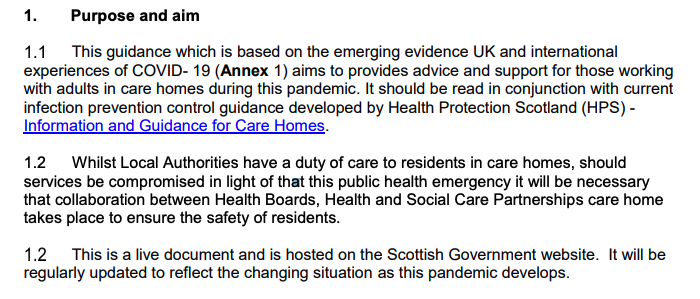 starts by setting out the purpose, which is to provide "advice and support for those working with adults in care homes during this pandemic". It is "based on the emerging evidence UK and international experiences of COVID- 19". Impressive." title="Like all good policy documents, https://abs.twimg.com/emoji/v2/... draggable="false" alt="🏴" title="Flag of Scotland" aria-label="Emoji: Flag of Scotland"> starts by setting out the purpose, which is to provide "advice and support for those working with adults in care homes during this pandemic". It is "based on the emerging evidence UK and international experiences of COVID- 19". Impressive." class="img-responsive" style="max-width:100%;"/>
starts by setting out the purpose, which is to provide "advice and support for those working with adults in care homes during this pandemic". It is "based on the emerging evidence UK and international experiences of COVID- 19". Impressive." title="Like all good policy documents, https://abs.twimg.com/emoji/v2/... draggable="false" alt="🏴" title="Flag of Scotland" aria-label="Emoji: Flag of Scotland"> starts by setting out the purpose, which is to provide "advice and support for those working with adults in care homes during this pandemic". It is "based on the emerging evidence UK and international experiences of COVID- 19". Impressive." class="img-responsive" style="max-width:100%;"/>
 equivalent is this https://www.gov.uk/governmen... which "is intended for care homes, local health protection teams, local authorities, clinical commissioning groups (CCGs) and registered providers of accommodation for people who need personal or nursing care"." title="The https://abs.twimg.com/emoji/v2/... draggable="false" alt="🏴" title="Flag of England" aria-label="Emoji: Flag of England"> equivalent is this https://www.gov.uk/governmen... which "is intended for care homes, local health protection teams, local authorities, clinical commissioning groups (CCGs) and registered providers of accommodation for people who need personal or nursing care"." class="img-responsive" style="max-width:100%;"/>
equivalent is this https://www.gov.uk/governmen... which "is intended for care homes, local health protection teams, local authorities, clinical commissioning groups (CCGs) and registered providers of accommodation for people who need personal or nursing care"." title="The https://abs.twimg.com/emoji/v2/... draggable="false" alt="🏴" title="Flag of England" aria-label="Emoji: Flag of England"> equivalent is this https://www.gov.uk/governmen... which "is intended for care homes, local health protection teams, local authorities, clinical commissioning groups (CCGs) and registered providers of accommodation for people who need personal or nursing care"." class="img-responsive" style="max-width:100%;"/>
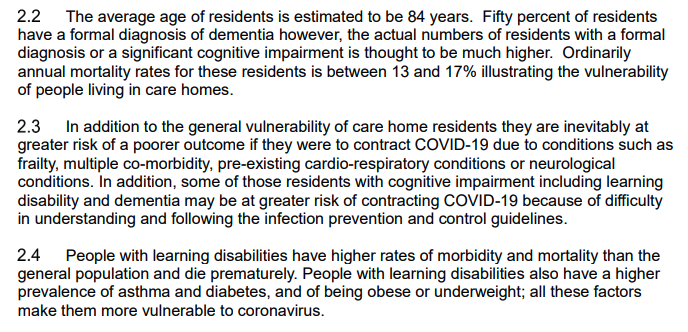 guidance sets out context on age and disability. It contains clinical info about co-morbidities leading to increased mortality. E.g. it says that people with learning disabilities have "higher prevalence of asthma and diabetes". Useful and important info for carers." title="The https://abs.twimg.com/emoji/v2/... draggable="false" alt="🏴" title="Flag of Scotland" aria-label="Emoji: Flag of Scotland"> guidance sets out context on age and disability. It contains clinical info about co-morbidities leading to increased mortality. E.g. it says that people with learning disabilities have "higher prevalence of asthma and diabetes". Useful and important info for carers." class="img-responsive" style="max-width:100%;"/>
guidance sets out context on age and disability. It contains clinical info about co-morbidities leading to increased mortality. E.g. it says that people with learning disabilities have "higher prevalence of asthma and diabetes". Useful and important info for carers." title="The https://abs.twimg.com/emoji/v2/... draggable="false" alt="🏴" title="Flag of Scotland" aria-label="Emoji: Flag of Scotland"> guidance sets out context on age and disability. It contains clinical info about co-morbidities leading to increased mortality. E.g. it says that people with learning disabilities have "higher prevalence of asthma and diabetes". Useful and important info for carers." class="img-responsive" style="max-width:100%;"/>
 document contains the following info about increased mortality risks of older people and people with learning disabilities:" title="In contrast, the https://abs.twimg.com/emoji/v2/... draggable="false" alt="🏴" title="Flag of England" aria-label="Emoji: Flag of England"> document contains the following info about increased mortality risks of older people and people with learning disabilities:" class="img-responsive" style="max-width:100%;"/>
document contains the following info about increased mortality risks of older people and people with learning disabilities:" title="In contrast, the https://abs.twimg.com/emoji/v2/... draggable="false" alt="🏴" title="Flag of England" aria-label="Emoji: Flag of England"> document contains the following info about increased mortality risks of older people and people with learning disabilities:" class="img-responsive" style="max-width:100%;"/>
 guidance acknowledges "the emergence of increased spread within the care home sectors". That& #39;s diplomatic. The High Commissioner for https://abs.twimg.com/emoji/v2/... draggable="false" alt="🇺🇳" title="Flag of United Nations" aria-label="Emoji: Flag of United Nations"> @UNHumanRights warned weeks ago that the Covid-19 risks "rampaging" through institutions." title="(Yes, that was a blank page) The https://abs.twimg.com/emoji/v2/... draggable="false" alt="🏴" title="Flag of Scotland" aria-label="Emoji: Flag of Scotland"> guidance acknowledges "the emergence of increased spread within the care home sectors". That& #39;s diplomatic. The High Commissioner for https://abs.twimg.com/emoji/v2/... draggable="false" alt="🇺🇳" title="Flag of United Nations" aria-label="Emoji: Flag of United Nations"> @UNHumanRights warned weeks ago that the Covid-19 risks "rampaging" through institutions." class="img-responsive" style="max-width:100%;"/>
guidance acknowledges "the emergence of increased spread within the care home sectors". That& #39;s diplomatic. The High Commissioner for https://abs.twimg.com/emoji/v2/... draggable="false" alt="🇺🇳" title="Flag of United Nations" aria-label="Emoji: Flag of United Nations"> @UNHumanRights warned weeks ago that the Covid-19 risks "rampaging" through institutions." title="(Yes, that was a blank page) The https://abs.twimg.com/emoji/v2/... draggable="false" alt="🏴" title="Flag of Scotland" aria-label="Emoji: Flag of Scotland"> guidance acknowledges "the emergence of increased spread within the care home sectors". That& #39;s diplomatic. The High Commissioner for https://abs.twimg.com/emoji/v2/... draggable="false" alt="🇺🇳" title="Flag of United Nations" aria-label="Emoji: Flag of United Nations"> @UNHumanRights warned weeks ago that the Covid-19 risks "rampaging" through institutions." class="img-responsive" style="max-width:100%;"/>
 guidance says nothing about DNACPR, while the https://abs.twimg.com/emoji/v2/... draggable="false" alt="🏴" title="Flag of Scotland" aria-label="Emoji: Flag of Scotland"> guidance says the following, including a prohibition against a blanket approach:" title="The https://abs.twimg.com/emoji/v2/... draggable="false" alt="🏴" title="Flag of England" aria-label="Emoji: Flag of England"> guidance says nothing about DNACPR, while the https://abs.twimg.com/emoji/v2/... draggable="false" alt="🏴" title="Flag of Scotland" aria-label="Emoji: Flag of Scotland"> guidance says the following, including a prohibition against a blanket approach:" class="img-responsive" style="max-width:100%;"/>
guidance says nothing about DNACPR, while the https://abs.twimg.com/emoji/v2/... draggable="false" alt="🏴" title="Flag of Scotland" aria-label="Emoji: Flag of Scotland"> guidance says the following, including a prohibition against a blanket approach:" title="The https://abs.twimg.com/emoji/v2/... draggable="false" alt="🏴" title="Flag of England" aria-label="Emoji: Flag of England"> guidance says nothing about DNACPR, while the https://abs.twimg.com/emoji/v2/... draggable="false" alt="🏴" title="Flag of Scotland" aria-label="Emoji: Flag of Scotland"> guidance says the following, including a prohibition against a blanket approach:" class="img-responsive" style="max-width:100%;"/>
 guidance does not mention eye protection or the difference between single or sessional use. The https://abs.twimg.com/emoji/v2/... draggable="false" alt="🏴" title="Flag of Scotland" aria-label="Emoji: Flag of Scotland"> guidance explains clearly:" title="As for PPE, the https://abs.twimg.com/emoji/v2/... draggable="false" alt="🏴" title="Flag of England" aria-label="Emoji: Flag of England"> guidance does not mention eye protection or the difference between single or sessional use. The https://abs.twimg.com/emoji/v2/... draggable="false" alt="🏴" title="Flag of Scotland" aria-label="Emoji: Flag of Scotland"> guidance explains clearly:" class="img-responsive" style="max-width:100%;"/>
guidance does not mention eye protection or the difference between single or sessional use. The https://abs.twimg.com/emoji/v2/... draggable="false" alt="🏴" title="Flag of Scotland" aria-label="Emoji: Flag of Scotland"> guidance explains clearly:" title="As for PPE, the https://abs.twimg.com/emoji/v2/... draggable="false" alt="🏴" title="Flag of England" aria-label="Emoji: Flag of England"> guidance does not mention eye protection or the difference between single or sessional use. The https://abs.twimg.com/emoji/v2/... draggable="false" alt="🏴" title="Flag of Scotland" aria-label="Emoji: Flag of Scotland"> guidance explains clearly:" class="img-responsive" style="max-width:100%;"/>
 document tells care home staff what to do:" title="What about "clinically extremely vulnerable" residents? They should be shielded. The https://abs.twimg.com/emoji/v2/... draggable="false" alt="🏴" title="Flag of England" aria-label="Emoji: Flag of England"> document tells care home staff what to do:" class="img-responsive" style="max-width:100%;"/>
document tells care home staff what to do:" title="What about "clinically extremely vulnerable" residents? They should be shielded. The https://abs.twimg.com/emoji/v2/... draggable="false" alt="🏴" title="Flag of England" aria-label="Emoji: Flag of England"> document tells care home staff what to do:" class="img-responsive" style="max-width:100%;"/>

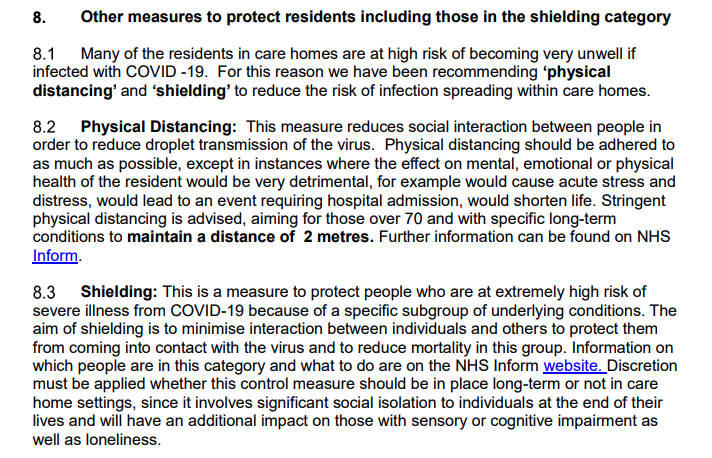 , care homes are given this practical advice:" title="So you& #39;re a carer working in a care home and you& #39;re told that the resident should not leave their house. Eh? Meanwhile in https://abs.twimg.com/emoji/v2/... draggable="false" alt="🏴" title="Flag of Scotland" aria-label="Emoji: Flag of Scotland">, care homes are given this practical advice:" class="img-responsive" style="max-width:100%;"/>
, care homes are given this practical advice:" title="So you& #39;re a carer working in a care home and you& #39;re told that the resident should not leave their house. Eh? Meanwhile in https://abs.twimg.com/emoji/v2/... draggable="false" alt="🏴" title="Flag of Scotland" aria-label="Emoji: Flag of Scotland">, care homes are given this practical advice:" class="img-responsive" style="max-width:100%;"/>
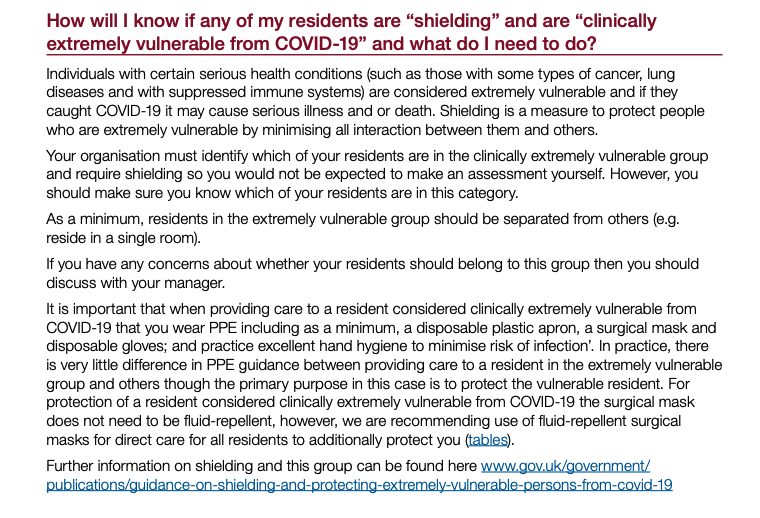 is on the left and https://abs.twimg.com/emoji/v2/... draggable="false" alt="🏴" title="Flag of Scotland" aria-label="Emoji: Flag of Scotland"> is on the right. Which in your view provides clearer guidance? https://abs.twimg.com/emoji/v2/... draggable="false" alt="🧐" title="Face with monocle" aria-label="Emoji: Face with monocle">" title="Side by side, here is the advice on shielding in care homes. https://abs.twimg.com/emoji/v2/... draggable="false" alt="🏴" title="Flag of England" aria-label="Emoji: Flag of England"> is on the left and https://abs.twimg.com/emoji/v2/... draggable="false" alt="🏴" title="Flag of Scotland" aria-label="Emoji: Flag of Scotland"> is on the right. Which in your view provides clearer guidance? https://abs.twimg.com/emoji/v2/... draggable="false" alt="🧐" title="Face with monocle" aria-label="Emoji: Face with monocle">">
is on the left and https://abs.twimg.com/emoji/v2/... draggable="false" alt="🏴" title="Flag of Scotland" aria-label="Emoji: Flag of Scotland"> is on the right. Which in your view provides clearer guidance? https://abs.twimg.com/emoji/v2/... draggable="false" alt="🧐" title="Face with monocle" aria-label="Emoji: Face with monocle">" title="Side by side, here is the advice on shielding in care homes. https://abs.twimg.com/emoji/v2/... draggable="false" alt="🏴" title="Flag of England" aria-label="Emoji: Flag of England"> is on the left and https://abs.twimg.com/emoji/v2/... draggable="false" alt="🏴" title="Flag of Scotland" aria-label="Emoji: Flag of Scotland"> is on the right. Which in your view provides clearer guidance? https://abs.twimg.com/emoji/v2/... draggable="false" alt="🧐" title="Face with monocle" aria-label="Emoji: Face with monocle">">
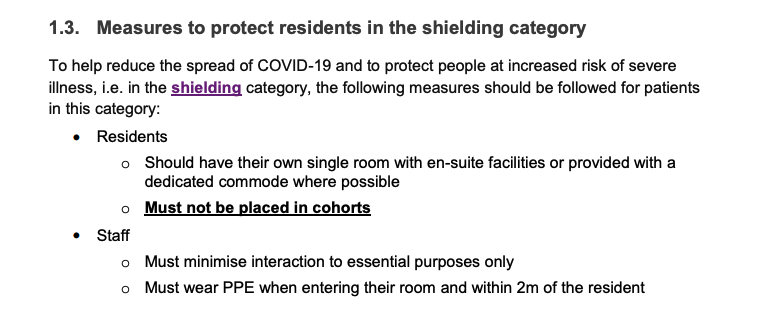 is on the left and https://abs.twimg.com/emoji/v2/... draggable="false" alt="🏴" title="Flag of Scotland" aria-label="Emoji: Flag of Scotland"> is on the right. Which in your view provides clearer guidance? https://abs.twimg.com/emoji/v2/... draggable="false" alt="🧐" title="Face with monocle" aria-label="Emoji: Face with monocle">" title="Side by side, here is the advice on shielding in care homes. https://abs.twimg.com/emoji/v2/... draggable="false" alt="🏴" title="Flag of England" aria-label="Emoji: Flag of England"> is on the left and https://abs.twimg.com/emoji/v2/... draggable="false" alt="🏴" title="Flag of Scotland" aria-label="Emoji: Flag of Scotland"> is on the right. Which in your view provides clearer guidance? https://abs.twimg.com/emoji/v2/... draggable="false" alt="🧐" title="Face with monocle" aria-label="Emoji: Face with monocle">">
is on the left and https://abs.twimg.com/emoji/v2/... draggable="false" alt="🏴" title="Flag of Scotland" aria-label="Emoji: Flag of Scotland"> is on the right. Which in your view provides clearer guidance? https://abs.twimg.com/emoji/v2/... draggable="false" alt="🧐" title="Face with monocle" aria-label="Emoji: Face with monocle">" title="Side by side, here is the advice on shielding in care homes. https://abs.twimg.com/emoji/v2/... draggable="false" alt="🏴" title="Flag of England" aria-label="Emoji: Flag of England"> is on the left and https://abs.twimg.com/emoji/v2/... draggable="false" alt="🏴" title="Flag of Scotland" aria-label="Emoji: Flag of Scotland"> is on the right. Which in your view provides clearer guidance? https://abs.twimg.com/emoji/v2/... draggable="false" alt="🧐" title="Face with monocle" aria-label="Emoji: Face with monocle">">
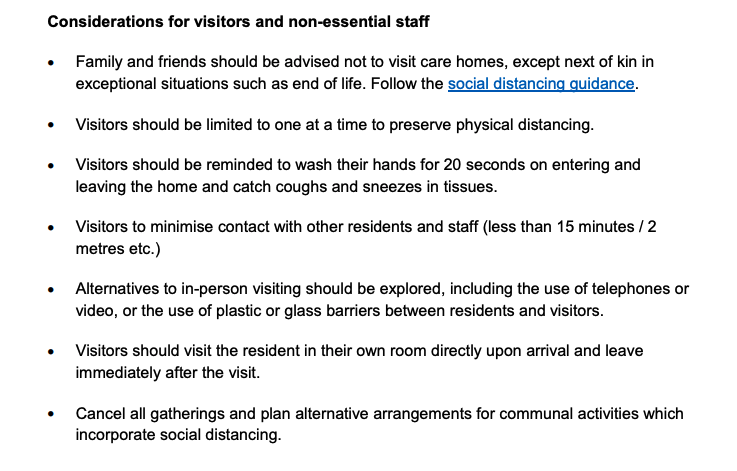 left and https://abs.twimg.com/emoji/v2/... draggable="false" alt="🏴" title="Flag of Scotland" aria-label="Emoji: Flag of Scotland"> right. Note the use of the term "loved one". Read the last bullet point in the https://abs.twimg.com/emoji/v2/... draggable="false" alt="🏴" title="Flag of Scotland" aria-label="Emoji: Flag of Scotland"> document https://abs.twimg.com/emoji/v2/... draggable="false" alt="😭" title="Loudly crying face" aria-label="Emoji: Loudly crying face"> The https://abs.twimg.com/emoji/v2/... draggable="false" alt="🏴" title="Flag of England" aria-label="Emoji: Flag of England"> guidance seems bereft of humanity." title="Also contrast the difference in approach to visits by family. Again, https://abs.twimg.com/emoji/v2/... draggable="false" alt="🏴" title="Flag of England" aria-label="Emoji: Flag of England"> left and https://abs.twimg.com/emoji/v2/... draggable="false" alt="🏴" title="Flag of Scotland" aria-label="Emoji: Flag of Scotland"> right. Note the use of the term "loved one". Read the last bullet point in the https://abs.twimg.com/emoji/v2/... draggable="false" alt="🏴" title="Flag of Scotland" aria-label="Emoji: Flag of Scotland"> document https://abs.twimg.com/emoji/v2/... draggable="false" alt="😭" title="Loudly crying face" aria-label="Emoji: Loudly crying face"> The https://abs.twimg.com/emoji/v2/... draggable="false" alt="🏴" title="Flag of England" aria-label="Emoji: Flag of England"> guidance seems bereft of humanity.">
left and https://abs.twimg.com/emoji/v2/... draggable="false" alt="🏴" title="Flag of Scotland" aria-label="Emoji: Flag of Scotland"> right. Note the use of the term "loved one". Read the last bullet point in the https://abs.twimg.com/emoji/v2/... draggable="false" alt="🏴" title="Flag of Scotland" aria-label="Emoji: Flag of Scotland"> document https://abs.twimg.com/emoji/v2/... draggable="false" alt="😭" title="Loudly crying face" aria-label="Emoji: Loudly crying face"> The https://abs.twimg.com/emoji/v2/... draggable="false" alt="🏴" title="Flag of England" aria-label="Emoji: Flag of England"> guidance seems bereft of humanity." title="Also contrast the difference in approach to visits by family. Again, https://abs.twimg.com/emoji/v2/... draggable="false" alt="🏴" title="Flag of England" aria-label="Emoji: Flag of England"> left and https://abs.twimg.com/emoji/v2/... draggable="false" alt="🏴" title="Flag of Scotland" aria-label="Emoji: Flag of Scotland"> right. Note the use of the term "loved one". Read the last bullet point in the https://abs.twimg.com/emoji/v2/... draggable="false" alt="🏴" title="Flag of Scotland" aria-label="Emoji: Flag of Scotland"> document https://abs.twimg.com/emoji/v2/... draggable="false" alt="😭" title="Loudly crying face" aria-label="Emoji: Loudly crying face"> The https://abs.twimg.com/emoji/v2/... draggable="false" alt="🏴" title="Flag of England" aria-label="Emoji: Flag of England"> guidance seems bereft of humanity.">
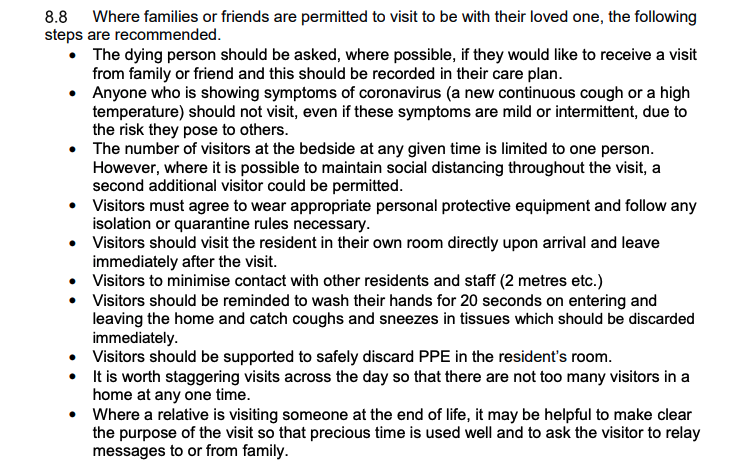 left and https://abs.twimg.com/emoji/v2/... draggable="false" alt="🏴" title="Flag of Scotland" aria-label="Emoji: Flag of Scotland"> right. Note the use of the term "loved one". Read the last bullet point in the https://abs.twimg.com/emoji/v2/... draggable="false" alt="🏴" title="Flag of Scotland" aria-label="Emoji: Flag of Scotland"> document https://abs.twimg.com/emoji/v2/... draggable="false" alt="😭" title="Loudly crying face" aria-label="Emoji: Loudly crying face"> The https://abs.twimg.com/emoji/v2/... draggable="false" alt="🏴" title="Flag of England" aria-label="Emoji: Flag of England"> guidance seems bereft of humanity." title="Also contrast the difference in approach to visits by family. Again, https://abs.twimg.com/emoji/v2/... draggable="false" alt="🏴" title="Flag of England" aria-label="Emoji: Flag of England"> left and https://abs.twimg.com/emoji/v2/... draggable="false" alt="🏴" title="Flag of Scotland" aria-label="Emoji: Flag of Scotland"> right. Note the use of the term "loved one". Read the last bullet point in the https://abs.twimg.com/emoji/v2/... draggable="false" alt="🏴" title="Flag of Scotland" aria-label="Emoji: Flag of Scotland"> document https://abs.twimg.com/emoji/v2/... draggable="false" alt="😭" title="Loudly crying face" aria-label="Emoji: Loudly crying face"> The https://abs.twimg.com/emoji/v2/... draggable="false" alt="🏴" title="Flag of England" aria-label="Emoji: Flag of England"> guidance seems bereft of humanity.">
left and https://abs.twimg.com/emoji/v2/... draggable="false" alt="🏴" title="Flag of Scotland" aria-label="Emoji: Flag of Scotland"> right. Note the use of the term "loved one". Read the last bullet point in the https://abs.twimg.com/emoji/v2/... draggable="false" alt="🏴" title="Flag of Scotland" aria-label="Emoji: Flag of Scotland"> document https://abs.twimg.com/emoji/v2/... draggable="false" alt="😭" title="Loudly crying face" aria-label="Emoji: Loudly crying face"> The https://abs.twimg.com/emoji/v2/... draggable="false" alt="🏴" title="Flag of England" aria-label="Emoji: Flag of England"> guidance seems bereft of humanity." title="Also contrast the difference in approach to visits by family. Again, https://abs.twimg.com/emoji/v2/... draggable="false" alt="🏴" title="Flag of England" aria-label="Emoji: Flag of England"> left and https://abs.twimg.com/emoji/v2/... draggable="false" alt="🏴" title="Flag of Scotland" aria-label="Emoji: Flag of Scotland"> right. Note the use of the term "loved one". Read the last bullet point in the https://abs.twimg.com/emoji/v2/... draggable="false" alt="🏴" title="Flag of Scotland" aria-label="Emoji: Flag of Scotland"> document https://abs.twimg.com/emoji/v2/... draggable="false" alt="😭" title="Loudly crying face" aria-label="Emoji: Loudly crying face"> The https://abs.twimg.com/emoji/v2/... draggable="false" alt="🏴" title="Flag of England" aria-label="Emoji: Flag of England"> guidance seems bereft of humanity.">
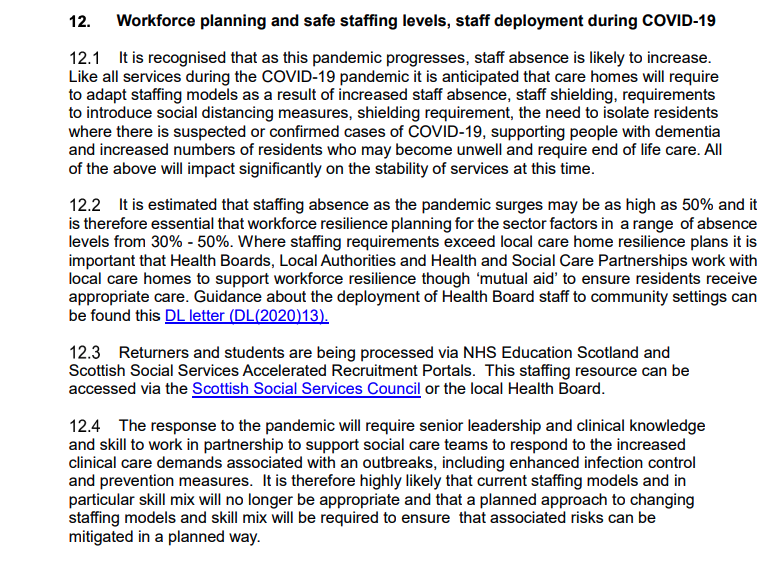 guidance has no references to workforce and only 2 references to staffing (weird, as that& #39;s a major issue), the https://abs.twimg.com/emoji/v2/... draggable="false" alt="🏴" title="Flag of Scotland" aria-label="Emoji: Flag of Scotland"> guidance has 8 paragraphs on workforce planning:" title="While the https://abs.twimg.com/emoji/v2/... draggable="false" alt="🏴" title="Flag of England" aria-label="Emoji: Flag of England"> guidance has no references to workforce and only 2 references to staffing (weird, as that& #39;s a major issue), the https://abs.twimg.com/emoji/v2/... draggable="false" alt="🏴" title="Flag of Scotland" aria-label="Emoji: Flag of Scotland"> guidance has 8 paragraphs on workforce planning:">
guidance has no references to workforce and only 2 references to staffing (weird, as that& #39;s a major issue), the https://abs.twimg.com/emoji/v2/... draggable="false" alt="🏴" title="Flag of Scotland" aria-label="Emoji: Flag of Scotland"> guidance has 8 paragraphs on workforce planning:" title="While the https://abs.twimg.com/emoji/v2/... draggable="false" alt="🏴" title="Flag of England" aria-label="Emoji: Flag of England"> guidance has no references to workforce and only 2 references to staffing (weird, as that& #39;s a major issue), the https://abs.twimg.com/emoji/v2/... draggable="false" alt="🏴" title="Flag of Scotland" aria-label="Emoji: Flag of Scotland"> guidance has 8 paragraphs on workforce planning:">
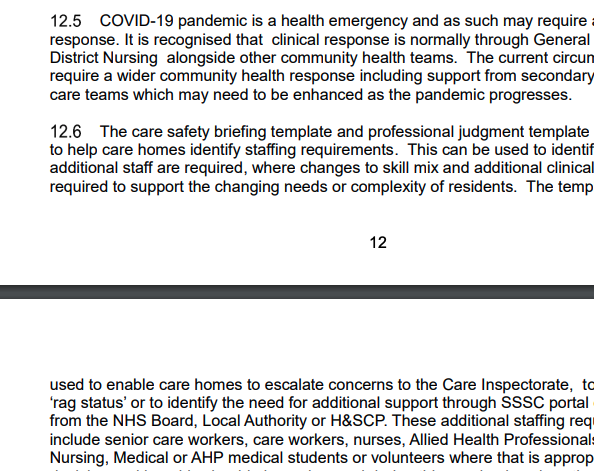 guidance has no references to workforce and only 2 references to staffing (weird, as that& #39;s a major issue), the https://abs.twimg.com/emoji/v2/... draggable="false" alt="🏴" title="Flag of Scotland" aria-label="Emoji: Flag of Scotland"> guidance has 8 paragraphs on workforce planning:" title="While the https://abs.twimg.com/emoji/v2/... draggable="false" alt="🏴" title="Flag of England" aria-label="Emoji: Flag of England"> guidance has no references to workforce and only 2 references to staffing (weird, as that& #39;s a major issue), the https://abs.twimg.com/emoji/v2/... draggable="false" alt="🏴" title="Flag of Scotland" aria-label="Emoji: Flag of Scotland"> guidance has 8 paragraphs on workforce planning:">
guidance has no references to workforce and only 2 references to staffing (weird, as that& #39;s a major issue), the https://abs.twimg.com/emoji/v2/... draggable="false" alt="🏴" title="Flag of Scotland" aria-label="Emoji: Flag of Scotland"> guidance has 8 paragraphs on workforce planning:" title="While the https://abs.twimg.com/emoji/v2/... draggable="false" alt="🏴" title="Flag of England" aria-label="Emoji: Flag of England"> guidance has no references to workforce and only 2 references to staffing (weird, as that& #39;s a major issue), the https://abs.twimg.com/emoji/v2/... draggable="false" alt="🏴" title="Flag of Scotland" aria-label="Emoji: Flag of Scotland"> guidance has 8 paragraphs on workforce planning:">
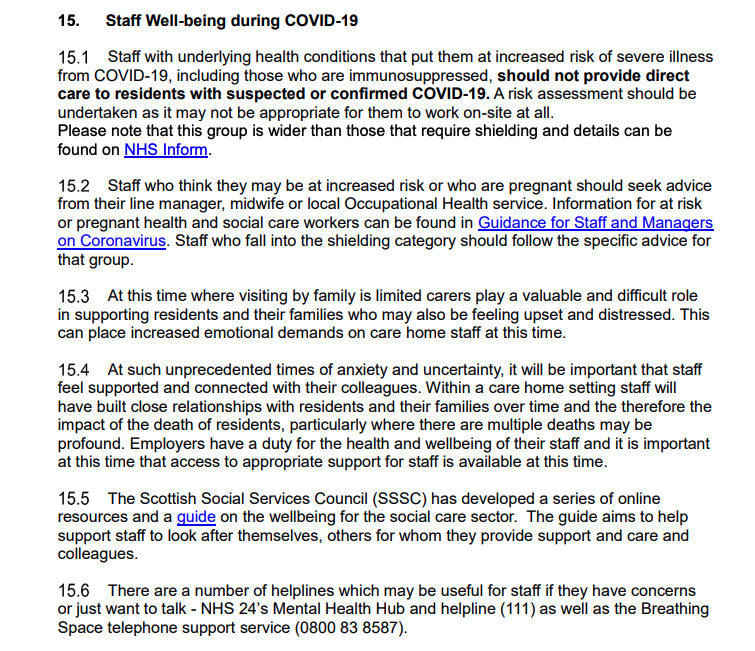 guidance says "At such unprecedented times of anxiety and uncertainty, it will be important that staff feel supported and connected with their colleagues." and then provides a load of resources. Yup, you& #39;ve guessed it, the https://abs.twimg.com/emoji/v2/... draggable="false" alt="🏴" title="Flag of England" aria-label="Emoji: Flag of England"> guidance says jack sh*t." title="On staff wellbeing, the https://abs.twimg.com/emoji/v2/... draggable="false" alt="🏴" title="Flag of Scotland" aria-label="Emoji: Flag of Scotland"> guidance says "At such unprecedented times of anxiety and uncertainty, it will be important that staff feel supported and connected with their colleagues." and then provides a load of resources. Yup, you& #39;ve guessed it, the https://abs.twimg.com/emoji/v2/... draggable="false" alt="🏴" title="Flag of England" aria-label="Emoji: Flag of England"> guidance says jack sh*t." class="img-responsive" style="max-width:100%;"/>
guidance says "At such unprecedented times of anxiety and uncertainty, it will be important that staff feel supported and connected with their colleagues." and then provides a load of resources. Yup, you& #39;ve guessed it, the https://abs.twimg.com/emoji/v2/... draggable="false" alt="🏴" title="Flag of England" aria-label="Emoji: Flag of England"> guidance says jack sh*t." title="On staff wellbeing, the https://abs.twimg.com/emoji/v2/... draggable="false" alt="🏴" title="Flag of Scotland" aria-label="Emoji: Flag of Scotland"> guidance says "At such unprecedented times of anxiety and uncertainty, it will be important that staff feel supported and connected with their colleagues." and then provides a load of resources. Yup, you& #39;ve guessed it, the https://abs.twimg.com/emoji/v2/... draggable="false" alt="🏴" title="Flag of England" aria-label="Emoji: Flag of England"> guidance says jack sh*t." class="img-responsive" style="max-width:100%;"/>


